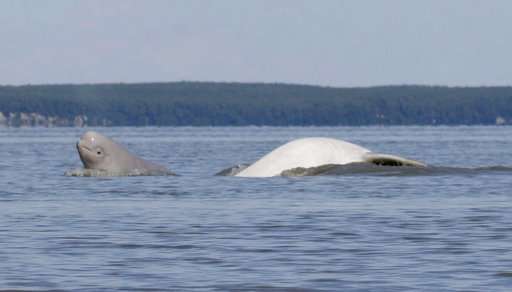Research shows diet shift of beluga whales in Alaska inlet

Beluga whales in Alaska's Cook Inlet may have changed their diet over five decades from saltwater prey to fish and crustaceans influenced by freshwater, according to a study by University of Alaska Fairbanks researchers.
An analysis of isotopes in beluga bone and teeth showed belugas formerly fed on prey that had little contact with freshwater. More recent generations of belugas fed in areas where rivers pour freshwater into ocean habitats.
New information on Cook Inlet belugas is important because the species is endangered and its numbers have not increased despite hunting restrictions and other protections. Mark Nelson, a wildlife biologist for the Alaska Department of Fish and Game and the lead author of the study, called it a little piece of that puzzle.
"If there's something we can do to help them recover, we might start to know what that might be," he said in a phone interview from Fairbanks.
A population of 1,300 belugas in Cook Inlet dwindled steadily through the 1980s and early 1990s. Alaska Natives harvested nearly half the remaining 650 whales between 1994 and 1998. Subsistence hunting ended in 1999 but the population remains at only about 340 animals.
Belugas feed on fish, crab, shrimp, squid and clams. Nelson as part of graduate work joined other researchers to analyze samples of cheekbones and teeth of beluga whales that died between 1964 and 2007.
They first looked carbon and nitrogen isotopes taken from bone, which is replenished by a whale's diet throughout its life.
The analysis indicated that feeding had changed between generations. That could have signaled a prey change from ocean-bottom creatures to fish, Nelson said. It could have meant belugas were leaving Cook Inlet to feed. Researchers said both were unlikely and turned their attention to beluga teeth.
Like tree rings, teeth have annual growth layers. Measuring isotopes in the growth layers reveals how feeding habits by an individual changed over its life, Nelson said.
A key question, Nelson said, was when change occurred in feeding habits and whether the change could be linked to documented events, such as a change in herring abundance or even the 1964 Great Alaska Earthquake. Researchers found no evidence of a sudden change in diet.
"It was a pretty steady change over the whole course of time, the whole course of that almost 50 years of data," Nelson said.
Researchers then analyzed strontium isotopes in teeth. They established that belugas might be eating the same food but that their prey was coming from areas of Cook Inlet influenced by fresh water. That meshed with data from aerial surveys indicating recent generations of belugas were spending time in upper Cook Inlet near big rivers such as the Kenai and the Susitna.
"From that, we were able to say that not only are they spending more time in the freshwater environments, they're actually getting most of their food from that freshwater environment," Nelson said.
Verena Gill, a marine mammal specialist with the National Oceanic and Atmospheric Administration, said the findings are significant because they cover five decades.
"We know that it is a real change rather than an anomalous year or two," she said.
The study tells NOAA administrators that the Cook Inlet belugas' shift to more freshwater-influenced habitat began long before the documented population decline, Gill said.
"However, whether this is due to a change in prey availability or foraging location of whales has yet to be determined," Gill said.
NOAA announced in September it was granting $1.3 million to Alaska for additional beluga research.
Researchers will analyze more teeth and pin down strontium signatures of water samples to determine what areas of Cook Inlet are important to belugas, Nelson said. Isotope research will be coupled with acoustic recorder research, which can determine where belugas are spending time and where they are feeding. Much is known about summer feeding habits but not much about winter habits.
"Understanding that better could be a real key here," Nelson said.
© 2018 The Associated Press. All rights reserved.



















